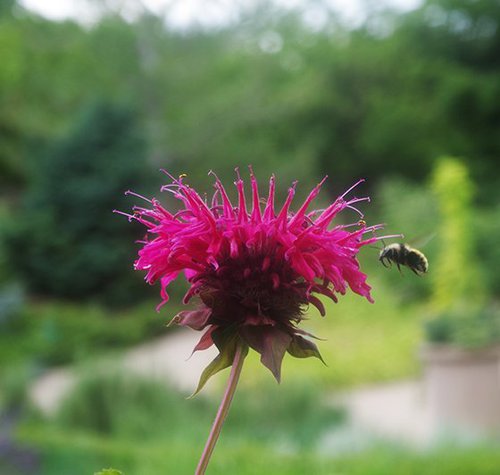
Pollinator Week: Native Bees in the Garden
Submitted: June 21, 2017, 3 p.m.

Many of the Red Butte Garden’s regular visitors view the Garden as their sanctuary — a refuge from the stresses, strains, and pressures of everyday life. An abundance of birds and other mammals also find refuge here and make their permanent or temporary homes in the Garden.
Recently we discovered that mammals and birds aren’t the only animals for which Red Butte Garden is a sanctuary. Joe Wilson, a professor of Entomology at Utah State University, studied the bee fauna of the Garden in 2015-16 and discovered 127 different species of bees, from 33 different genera, and all six North American bee families. Unlike honey bees (Apis mellifera), very few native bees sting people.
The abundance of bee species in the Garden varied across the seasons, they were most abundant and diverse in the spring and gradually decreased as the season progressed. Bees in the genus Andrena, commonly called the mining bee, were most abundant with over 20 represented species. A variety of bumble bees (Bombus) were found to be doing very well in the Garden in contrast to the population declines they are experiencing elsewhere—emphasizing, according to Wilson, the importance of the Garden’s role in protecting native bees.
Wilson found a number of specialist bees including a cactus specialist (Diadasia australis), a squash family specialist (Peponapis pruinosa), and a variety of sunflower family specialists. Specialist bees forage for pollen that can be found on only a few or even just one plant species.
Interestingly, the bee species in the formal garden areas were markedly different than those found in the Natural Area. Of the 83 species collected in the formal garden areas, 33 were only found there, and of the 86 species found in the Natural Area, 48 were only found there, with 53 species found in both areas. Professor Wilson’s report concluded that Red Butte Garden is an important refuge for bees in heavily developed Salt Lake County, providing a continuous, predictable, reliable supply of floral resources and a consistent source of undisturbed nesting areas.
The Garden takes its role of sanctuary very seriously. We are a refuge for children to play in nature, for adults to escape from their stresses, for animals, birds and yes, for bees.